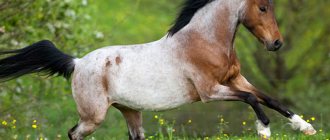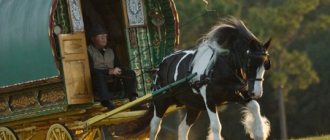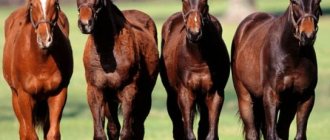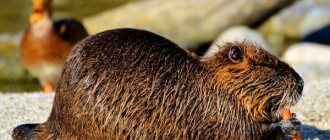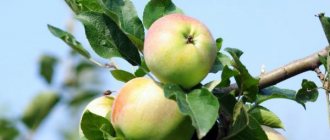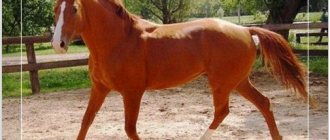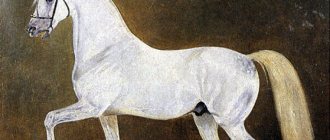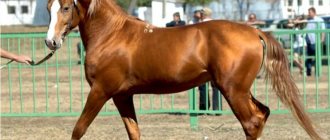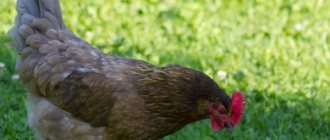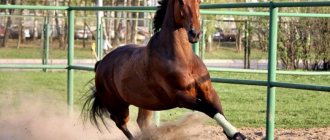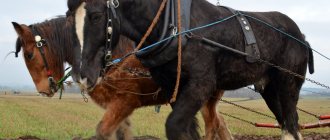The brown horse owes its origin to wild representatives of this genus. This is both Przewalski's horse and the now exterminated tarpan. Domesticated horses that have not been subject to deep selective selection may have this color.
It is not for nothing that in Russian fairy tales such horses were distinguished by their violent temperament.
The main characteristic colors of the brown suit are sandy, light reddish-brown.
But the distant ancestors of today's horse rarely had a similar color. The brown color arose relatively recently due to mutation processes and the combination of genes of wild and domestic individuals.
The origin of brown color and its features
Brown color is considered a rather rare type of horse coat color and is found in zonal or wild colors.
Modern horses received the kaurasti shade by inheritance from distant ancestors who inhabited the planet many millions of years before the appearance of man. Kaurasti arose due to the influence of the DUN gene, the so-called wild color gene, on the hair pigment. Horses that have this gene are considered the oldest. They are usually called “wild colors”. What makes DUN unique is that it is based on a red color and has a brightening effect. It affects the black and red pigment of the coat at the same time, but does not lighten the entire coat. The mane, tail and lower limbs are not susceptible to bleaching. The coloration of a horse, which is based on the DUN gene, is an excellent camouflage in any terrain and makes it possible to go unnoticed, which is of great importance for the preservation of populations. It is worth noting that horses that have the “wild gene” have common color features.
Another distinctive feature appears as a dark brown or black stripe running along the horse's spine (the "strap") and darkening on the horse's shoulder blades. Thanks to the above characteristics, the zonal suits are combined into one, which is called Savrasaya and is divided into the bulano-savrasaya, bay-savrasaya, raven-savrasaya (mousy) and red-savrasaya (brown) suits.
A horse of brown color has a light red or, more precisely, faded body color. The color of the head and legs is a more saturated shade than the main one. The mane and tail consist of a mixture of strands of dark brown, dark red and light colors, and are the brightest parts of the hairline. As for primitive markings, the belt has a red-brown or dark red color. And the horizontal stripes located in the area of the hock joint are marked with a brown tint. Over the years, all horses turn gray. Color saturation, becoming duller. The brightness of the coat is also affected by the seasons. It gets brighter in winter and darker in summer.
- Dark brown color of the horse. The body is dark red in color. The head and lower parts of the limbs are several shades darker. The stripe running along the ridge is dark brown. The mane and tail consist of dark red, dark brown and light strands and are the darkest parts of the horse's hair. Zebra and minor spots on the shoulder blades are brown.
- Brown horse color. The body is light red in color. The head and lower parts of the legs are red. The animal's tail and mane are dark red. The strap and horizontal stripes located in the hock area are reddish-brown.
- Light brown color of the horse. The body is very light. The head and lower parts of the limbs are slightly darker than the main part. As a rule, the mane and tail consist of a mixture of red and blond hair and, compared to the general background, appear to be the darkest parts of the horse's hair. Zebra, belt and partial darkening of the light brown color of the horse are red or light brown.
Nowadays, horses with brown coloring are rarely seen. On the territory of our country, they can be seen among the Altai breeds of mountain-type horses. In Kazakh breeds living on the territory of modern Kazakhstan. Among the Yakut breeds, which, according to scientists, have miraculously survived to this day. Rarely, but found in Soviet heavy-duty breeds.
In America, among such breeds of horses as Mustang, Criollo, Appaloosa, which were originally brought to Latin America by Spanish conquistadors. In Europe, the brown hue is noted in the Norwegian Fjord, which is considered the most ancient of all heavy drafts on the planet. Its “relative” is the Icelandic pony and the tallest Connemara pony, which lives in Ireland and prefers rocky terrain.
Basically, they have an easygoing character and are good-natured, although they are strong and in cases of danger will always be able to stand up for themselves. Average life expectancy is 25-30 years. Height and weight depend on the breed; care and nutrition are also important (the better the care, the larger the horse). In total, the height of a brown horse varies from 145-200 cm at the withers, and weight from 400-1000 kg (for example, brown horses of the Mustang and Altai breeds rarely exceed 150 cm and weigh between 400-600 kg, but the Soviet draft horse The brown-colored breed can reach 200 cm and weigh 800 kg).
Possible shades
There are several varieties of brown color, which depend on the tones of the coat color .
- Dark brown . Representatives of this color are distinguished by a dark red tone in the area of almost the entire body. The darkest shade of reddish is observed on a certain head part and limbs. The belt stripe near the ridge has a chocolate tint. The tail and mane include red and red shades with dark tints. In addition to this expressive color scheme of the body, there is zebra-shading and a small number of dim brownish spots in the area of the shoulder blades.
- Light red. The color of the body is a light reddish color; it is noteworthy that the head, mane, and tail are quite rich red. Zebra stripe, a belt stripe of a deeper red color with a brown tint.
- Light kauraya. This coloring is notable for the lightened part of the body, while the color of the head is darker, but in the same range. The mane and tail consist not only of red hair, but also very light hair, so the adjacent parts of the body look somewhat darker. Zebra stripes, stripes, spots have a pronounced red tint. This type of horse is most often presented at exhibitions, thematic forums and competitions at the hippodrome. In addition, there is an active use of these types of horses in agriculture.
What is brown color?
According to the research of scientists, we owe the term “kauriy” to the language of the Turks. It is based on the word “kovur”, meaning brown color. Moreover, it is the Turkic peoples who hold the palm in taming representatives of wild herds.
It is believed that this color is the result of mutation processes, therefore it is extremely rare in comparison with other “wild colors”: mousey, savras.
The tones of this color may differ due to the mixing of fur hairs of different tones. The brown color is very similar to the reddish color; accordingly, it is characterized by bright red shades, interspersed with reddish-red wool in the form of a strip along the ridge, reminiscent of a belt. The presence of stripes darker than the rest of the color on the joints is allowed. This distinctive feature is called zebraing.
All “wild colors” are characterized by darkened wrists, mane and tail, close in color to brown tones. As for the groin area, abdomen, muzzle, these are more lightened areas, thanks to the lightening gene DUN, it is able to act only on certain areas of the body. In the wild, this color allows the horse to hide perfectly and provides excellent camouflage in the natural environment.
In spring and summer the color is more saturated, from autumn to the end of winter it is lighter.
In old age, the brown horse begins to turn gray quite actively, and the color fades.
Breeds
Most often, representatives of the brown color are related to the steppe. This color is common in large percentages among such representatives:
- Altai;
- Yakut;
- Bashkir;
- Kazakh;
- Soviet heavy truck is a very rare phenomenon.
Brown color can never be seen among horses. As for European breeds, the most common color is among the large Irish Connemara ponies; the Fjord heavy horses of Norway also have a similar color, although more lightened. On the American continent, brown color is found in mustangs. In addition to those listed, brownness is found in many mixed American-Spanish breeds:
Very often, brownness is observed precisely in those breeds that occurred as a result of crossing domestic horses with wild representatives of the breed.
This color itself is rare and is related to wild colors. Therefore, brownness can only be observed in those breeds whose ancestors included wild horses.
This issue should be carefully studied before purchasing an animal.
The horse is a herd animal, so loneliness is contraindicated for it. It has a bad effect on her condition, mood and development.
She needs the company of people like her. Brown horses also need company, just like other representatives. If maintaining a whole herd is not part of the owners’ plans, or this is impossible for other reasons, you can create a company by having several sheep or goats.
It is extremely important to provide competent care for animals so that they are healthy, hardy, develop well and maintain their external properties. One of the most important conditions for the healthy development of horses is physical activity.
This happens in the summer, when horses graze and “walk” enough. During cold weather, the lack of regular walks can become a problem, since the animal spends most of its time in the stall.
Despite the cold, a four-hour walk on a daily basis is absolutely necessary for horses.
In addition to walking, proper and timely cleaning is very important. Under natural conditions, the horse cleans itself on its own, rolling on the ground. Keeping horses must include regular cleaning. Wash the horse completely
It is necessary to inspect the hooves every day, no matter where the horse is, what time of year it is, whether physical activity is present or not.
Another mandatory component of grooming procedures is a dental check and mane care.
It must be kept in order, combed, and not tangled, because it protects the neck and head. Teeth are an indicator of a horse's health, so check them at least once every six months. Horses are shoed at least once every 2 months.
Recommendations
When purchasing a horse, you must take into account that this is a herd animal. He does not like to be alone and always needs “company”, this also applies to the brown color of the horse. Not many people can afford to own several horses, but by purchasing a few more sheep or goats, you will create excellent company for your pet.
Since the horse is a herbivore, its diet consists of hay and oats, but if necessary, hay can always be replaced with straw. In the summer, the horse grazes on pasture and consumes up to 100 kg of grass during the day (depending on the age of the horse). In winter, she needs more food to keep warm. The amount of food per day depends on her age and body weight. But, like a person, she needs to drink more, so she needs to consume up to 60 liters per day.
The horse needs special attention and care. The main need is physical activity. In the summer she spends most of her time on the pasture, thereby walking herself. But in winter he is in a stall and needs exercise. This walk should take 3-5 hours a day. The second necessity is cleaning the animal. Living in the wild, the horse cleans itself by rubbing it on the ground. But domestic horses need brushing, washing the entire body and inspecting the hooves 1-2 times a day, it all depends on the time of year, living conditions and physical activity. The condition of the mane directly affects the well-being of the animal, since the mane performs a protective function, protecting the neck and head from insects. Therefore, horse owners must keep the mane in order. The same applies to the horse’s teeth; it is recommended to check them every six months. And also the shoeing of the horse’s hooves, shoeing should be carried out every month and a half
The color of a horse is considered a fundamental external feature due to which species can differ. Any classification necessarily includes division according to this parameter - color. To determine the breed, an analysis of the horse's coat color, skin tone, and eye color is carried out. In addition, spots, areas of lightening or darkening, and shades of fur in certain places are considered significant signs.
Compliance with the regime
If you feed the gamefish at the same time, and also create good conditions for it to feed, the animal will get used to this way of life. After establishing a regime, the digestive system independently prepares for food intake. An animal may feel stressed if any nutritional disturbances occur.
The veterinarian should periodically monitor the animal, as well as the health of the individual’s teeth. It is advisable to eliminate and correct any problems that arise. It is recommended that all feed be properly processed so that the nutrients are well absorbed in the horse’s body. The presence of healthy teeth will create clear chewing, and as a result, saliva will be produced in sufficient quantities. Thanks to this process, the animal will avoid the formation of ulcers. It is necessary to select rough food as the main diet for females and males, because grinding will take more time.
Containment room
For indoor housing, spacious group stalls are best, where horses of the same age can move freely. Stalls and stalls are used as less comfortable premises. It is important here that they have open openings (windows) to communicate with other animals nearby. The minimum area of space per individual is 5 square meters. m.
The premises must be cleaned and cleaned regularly. Ceilings must be high for effective air ventilation. Drafts should not be allowed. The premises should have good access to natural light.
Stalls are better suited for winter housing, because in the event of an infectious disease, they will reduce the likelihood of the disease spreading.
Roan color gene
The Rn gene is a dominant trait that is not sex-linked. When crossing animals that both have the roan gene, the experiments ended in the death of all offspring.
The roan gene is not linked to any particular breed of horse, but a horse with a dark base color looks especially impressive.
Color may appear in different ways. Zonal and non-zonal. It depends on how the white hair is positioned. If they lie on the horse’s body in spots or stripes (like the Savras roan), then this is a zonal distribution. If small white hairs alternately cover the entire body. This is non-zonal coverage.
Signs of a noble roan horse:
- Eyes and hooves. Despite the dominant Rn gene, the eyes and hooves should remain dark in color, unless specific to the breed.
- Color constancy. Roan horses never turn gray if their base color is dark. Blonde hair tends to lose color saturation over time. But it will not completely lose pigment. The color of dark horses can become even darker over time.
- Season. Some varieties of roan color change the shade of their coat depending on the time of year. The exception is the mane, which always retains its natural noble shade.
- Tail. It retains its color throughout its life. With the exception of Savras-roan suit. A unique phenomenon is when there is a small white strand in the tail, which looks more like highlighting than a natural phenomenon.
- The former wounds are not visible. Unlike other horse masks, when a roan horse is wounded, hair of the same color grows at the site of the cut. It blends harmoniously with the rest of the color and after a while it is no longer possible to say exactly where the cut was.
Diet requirements
When purchasing a horse, you should remember that this odd-toed ungulate belongs to the herd type of animal. This means that the horse does not tolerate being alone and needs its own kind. Brown suit is no exception. Since not all livestock breeders have the opportunity to buy or maintain a stock of horses, you can create the necessary company for an animal by taking several sheep (goats are also suitable for joint breeding).
The horse does not tolerate being alone and needs its own kind
Horses are herbivores whose diet includes hay or oats. However, if necessary, straw can be used instead of oats. In the summer, equids are released onto pasture, where, depending on the age of the particular animal, it can consume up to 100 kg of grass. In winter, to better retain heat, the daily diet should include more food. The exact amount of feed is also determined by the characteristics of the individual horse. However, like all other representatives of the animal world, horses need water, the volume of consumption of which per individual is 65 liters.
Bay color
The bay color of the horse implies a brown body color. The same is true of wild horses. Accordingly, bay horses are close to them genetically. This is what is associated with the unpretentiousness and endurance of brown horses. They are the fastest, because in nature you often have to run away from predators and pursuers.
Natural selection gave the bays excellent health. Confirmation of this is the record holder among horses for life expectancy. His name is Billy. The gelding from Cleveland lived 62 years, with the average horse age being a quarter of a century.
They did not stand on ceremony with the gelding Billy. Until the end of his days and from a young age, the horse towed barges along the shore. This confirms the endurance of bays. It’s not for nothing that there is another record among them. We are talking about the most expensive stallion. His name is Frenkel. The horse costs 200 million dollars. The average cost of a horse is 5 thousand conventional units.
One of the most common horse colors is bay.
The bay color has 8 strokes. It's easy to imagine dark and light brown, bay, golden, chestnut and cherry. Two more names require decoding.
Bay-chestnut horse color
Underhair is characterized by bleached areas in the groin, elbows and eyes of the animal. It’s easy to remember if you know the term “tanned,” that is, darkening. Podlas is the opposite.
Underhair horse
The last bay option is the horse's karak color. The term is taken from Turkic. There “kara-kul” means “black-brown.” This is the essence of the name. The color of horses is characterized by a dark brown body and black legs, tail, and mane.
Karak horse
Wild horses are black with brown undersides. Domestic bays also have lighter limbs. They are white on a brown background. In adulthood, this coloration is rarely preserved. With age, the legs darken.
Young bay foals, on the contrary, have lighter limbs
Bay-piebald horse
Brown horse breeds
Horses of similar colors are found only in rare cases. In Russia they were seen only among Altai horses. Kazakh breeds and even Yakut horses have similar colors. They are found only in places where domestic horses could be crossed with wild stallions.
In America, brown color is found in horses of the following breeds:
- Criollo. The height of the horse is about 145-155 cm at the withers, the head is of medium size, large eyes, short body, massive neck, powerful and short legs.
- Appaloosa. The height is low, about 150-160 cm at the withers, the head is massive, the eyes are large, light, the neck is wide, the legs are strong.
- Mustang. Height is short, about 155-160 cm at the withers. A distinctive feature of the breed is its short body and massive legs.
Brown mustang
Norwegian horses also have a similar color, but these horses rarely participate in various tournaments - they are mainly used for working on farms.
Keeping fit
To keep the brown horse in shape, it must be walked regularly. In summer, constant grazing of herds is possible. The good weather resistance of brown breeds requires frequent exposure to fresh air. Pasturing allows horses to maintain good physical condition.
Red-brown horses are often used for work. But you need to adhere to several rules.
- Do not use for work in cold weather with temperatures below -10 °C.
- Before starting work, allow your muscles to stretch.
- Allow to get used to the temperature.
Features of suit distribution
According to preliminary data, we can say with complete confidence that the brown color is one of the rare ones. This is due to the presence of a special gene in the horse’s body. The brown horse is a real rarity, so it can be found most often in those places where ordinary mares and stallions were randomly crossed with wild representatives of horses living in nature. In addition to all the above breeds, which exhibit the characteristics of this color, it is also worth highlighting the following:
- Creole;
- Soviet heavy truck;
- Icelandic pony;
- Appaloosa;
- Connemara.
In addition, sometimes the color slips in horse breeds such as the mustang, but this is most likely due to the fact that the mustang is a real wild horse.
Due to the fact that it is very difficult to find such a suit, it is in demand in the modern world. In this situation, the main question is how to preserve this suit during the disappearance stage. This problem is currently being actively discussed.
Diet
Everyone knows that the horse is a herbivore animal. Therefore, the diet mainly consists of grass or hay, oats. Oats are easily replaced with straw. In the summer, horses graze on the grass and provide themselves with food, the volume of which reaches 100 kg for each individual.
In winter, you need to provide the horse with hay, and he needs more nutrition than in summer so that he does not freeze.
Of course, the animal needs to drink a lot of water. The volume of liquid consumed can reach more than 60 liters per representative.
Read more about the brown color of horses below.
Color is the main characteristic by which horse varieties are distinguished. It is impossible to identify a complete classification of a particular individual without an accurate determination of this parameter. To do this, you need to visually analyze the color of the coat, eye color and skin tone. The presence of pigment spots, darkened or lightened fragments and coat shades should also be taken into account. Belonging to any suit is primarily a hereditary indicator. The article describes what the brown color of a horse is.
Description of cow suit
There is an opinion that individuals inherited the rare brown color from their wild ancestors. Such horses lived in ancient times, judging by historical chronicles. In general, this color is distinguished by a warm brown tint of varying intensity, while the color of the legs and head of such a horse will always be slightly darker than the entire body.
Light colored brown horse
The following features are found in some individuals:
- dark marks all over the body;
- stripe on the back;
- black color of the limbs;
- stripe on the withers of a dark shade;
- long stripes on the front legs.
There are dark and light hairs on the animal’s head and body, which is why the mane and tail of brown horses look brighter. Light spots are present in the eye area, on the stomach and groin. With age, horses of brown color begin to show gray hair, and the red tint also changes depending on the time of year: in winter the horse has a lighter color, and in summer it is dark.
Horses come in both light and deep dark colors. Therefore, they are divided into certain subspecies.
Table 1. Varieties of colors
| Color | Description |
| Light brown | The body has fur of very light shades, the head and legs are slightly darker. The tail and mane consist of a mixture of dark and light hair, standing out against the background of the rest of the body. |
| Dark brown | The body has a dark red coat color. The legs and head are slightly darker. The mane and tail are dark in color. |
| Kauriy | The body is light in color, the limbs and head are golden. The tail and mane have the same rich color. |
Horses have an easy-going character and easily make contact with people. However, if necessary, they can stand up for themselves. On average, the life expectancy of individuals is 28-35 years. Height and weight characteristics depend on the breed of horse. Height ranges from 140-180 cm, weight can reach 900 kg.
Brown horses are less common than their counterparts of other colors.
Brown horses can be classified as an endangered subspecies. Because over the past decades, the total number of horses has greatly decreased due to the lack of need for riding. In addition, maintaining a horse requires large material costs.
Where did the name come from?
It is widely believed that the name of the suit comes from the word “brown”, which, in turn, comes from the Turkic kara (“black”). In Russian, dark brown shades are usually called karimi. But since there are also light versions of the brown color, the presented theory is often criticized.
In Russian, the word “kauritsya” means to be gloomy, stubborn and hateful. Therefore, it is likely that the suit got its name not because of the color, but because of the disposition of the wild horses. However, for the horses themselves, such a color is a vital necessity, helping to hide from enemies both in the steppes and in the undergrowth. This became especially relevant for young animals that were not yet able to withstand the attacks of predators.
Colors and breeds
Each breed has its own set of colors. In some breeds, color is an important selection trait, in others it is not of great importance. There are breeds that have only one color - for example, Friesians have only black color, Haflingers - only game color. There are breeds with a luxurious palette of colors and colors. These usually include native breeds. For example, Mongolian horses can be found in absolutely any color, while Icelandic horses do not have only dappled ones. Table 1 shows the colors and breeds of horses in which they are found.
Table 1
| Suit | Breed |
| Gray |
Rarely, but there is a gray color in:
French trotters never have a gray coat. |
| Voronaya |
Rarely found in trotting breeds:
|
| bay | Cleveland bays - there are no other colors in this breed. This is an extremely common color and is found in many thoroughbred, native and outbred horses. |
| Redhead | It is found in most existing breeds - heavy trucks, Kazakh steppe, Mezen, Pechora, Don and many others. The following breeds have the most red color:
|
| Isabella |
|
| Chubaraya |
|
| Piebald | Paint Horse is an American breed of piebald horse. Piebaldity is not found among factory breeds. Piebald color is common among ponies. Aboriginal and outbred horses can also be piebald. |
| Igrenovaya | Heavy truck breeds:
And also trotters:
|
| Savrasaya |
As well as wild mustangs and Przewalski's horses. Arabian and Trakehner horses are never of Savras color. |
| Roan | Bashkir heavy draft horses and noble breeds of horses. |
Thanks to nature and painstaking selection, there are horses with unique colors in the world. Understanding the variety of suits and patterns is not at all easy. But for those who love horses or are involved in breeding them, this is a very exciting and useful activity.
1
Breeds
Most often, representatives of the brown color are related to the steppe. This color is common in large percentages among such representatives:
- Altai;
- Yakut;
- Bashkir;
- Kazakh;
- Soviet heavy truck is a very rare phenomenon.
Brown color can never be seen among horses. As for European breeds, the most common color is among the large Irish Connemara ponies; the Fjord heavy horses of Norway also have a similar color, although more lightened. On the American continent, brown color is found in mustangs. In addition to those listed, brownness is found in many mixed American-Spanish breeds:
- quarter horse;
- criollo;
- appaloosa
This color itself is rare and is related to wild colors. Therefore, brownness can only be observed in those breeds whose ancestors included wild horses.
Where can I meet?
Brown individuals are not often found in Russian cities. They can be seen among the representatives of the Altai breed living in the mountains. There are brown individuals in Kazakhstan, as well as in Yakutia and Bashkiria. Sometimes they are distinguished among heavy draft types of different breeds.
On American lands, brown individuals are found among mustangs and criollos. European Browns are found in the Norwegian Fjord, Quarter Horse, and Appaloosa breeds. The Norwegian Fjord is one of the oldest breeds, coming to Scandinavia in the 4th millennium BC. e. In Iceland, the color represents the Icelandic pony.
The brown color (photo presented in the article) is very impressive, distinguished by its wild coloring of red tones, passed on to horses from distant ancestors. This suit cannot be confused with any other. The number of color representatives is limited. At exhibitions they become real highlights of the event.
Since the suit is on the verge of extinction, experts are faced with a difficult question: how to preserve it?
Suit overview
Before we talk about the features of the brown color, it should be said in general that among all horses there are main and also additional colors. The main ones include four types: black, bay, red, gray. All other horse colors are considered derivative. But there is a separate type called "wild" or "zonal" suits. They are characteristic of wild horses, as well as representatives of local aboriginal breeds.
Since all “zonal” colors have many common features, they are usually united under a common name - savrasaya. However, they all still differ from each other, so they are named with the prefix of the main color. For example, among such suits they distinguish between mouse, brown and savras. They are also called raven-savrasaya, red-savrasaya and bay-savrasaya.
Interesting! The main suits, according to geneticists, come from Savras, and not vice versa.
General features of “wild” horses
As we have already said, all three types of color have common features. So, in horses with this color, the main part of the body has a basic tone. But the mane, tail and lower parts of the limbs are colored darker. In this case, motley hairs and strands may be present throughout the body. It is also necessary to have clear spots in the muzzle area, on the stomach, around the eyes, on the buttocks and in the groin.
It's all in the genes
The brown color, like the savra and mousey ones close to this type, is determined by the special Dun gene. This gene is also called the “wild color gene” because it was passed on to modern horses from their ancestors. However, not all animals can inherit this color, but only those closest to the wild genotype. Today, for example, Przewalski's horses are like this, as in the photo. Also, “brownness” appears among modern breeds, for example, in some draft horses and local horses.
Many people confuse the actual savras and red-savras colors of horses. Yes, their differences are hardly noticeable, unlike the mouse ones. The main secret of recognition is the saturation of the fundamental tone. Everything where there is a brighter yellowish tint is called brown color. A pale shade of fur with a large number of dark strands and hair in the mane and tail speaks of pure savagery.
Features of the offset
The brown color is possible only when the Dun gene is combined with the main gene responsible for the red color. That is why such horses have a red main coat color and are called red-savras. Only in the abdomen, under the chest, as well as on the muzzle and around the eyes, lighter hair appears. At the same time, the tail, mane, and legs remain darker in color, reaching red-red. These parts of the body can also be light if the modifier gene is active.
Brown horses are encouraged to have so-called “wild” markings. This is a dark stripe along the ridge, zebra stripes on the legs, and also a transverse stripe on the withers (like donkeys). In addition, this color allows for a wide variety of basic shades among different breeds. For example, Przewalski's horses have a rich reddish-yellow body, as in the photo. But the Norwegian fjords are characterized by a lighter sandy shade.
Variety of shades
Although at first glance it may seem that this type of brush-off always has the same tone, this is not entirely true. Among the red-brown animals, various shades are also distinguished. For example, a dark brown horse has a base dark red coat color with all other "zonal" color features. A regular redhead is a light red base hair color with a dark mane, tail and limbs. The light shade is very close to salty in combination with other signs of savageness.
Where is it found?
Brown color, as you already understood, is a very rare type of horse color. Few breeds can have it. As a rule, these are local horses that were formed by crossing wild ones with domestic ones. For example, in our country such an unusual color is found among Altai, Kazakh, Yakut and some other aboriginal breeds. Sometimes this type of savrasity manifests itself in Soviet heavy trucks.
As for other countries, in Europe Icelandic ponies, Connemara ponies, as well as representatives of the Norwegian Fjord breed have a red-brown color. In America, this color is characteristic of mustangs, quarter jockeys, appaloosa and criollo breeds. See photos of these horses below.
Strap on the back of a marePrzewalski's horses in the pastureBeautiful light mare
From the history of appearance
It is generally accepted that the brown color of modern horses was inherited from wild ancestors who lived on the planet a long time ago.
The color comes from a gene called Dun. It, in turn, has a simultaneous effect on the black and red pigment in the animal’s fur, but there is no effect on the color of the mane, tail and lower legs. Dun connects to the central gene responsible for the red color, and in this case the brown color appears. In other words, three genes are responsible for the formation of color:
- Extentition - explains the black pigment, while it is recessive homozygous.
- Agouti - replaces black with white, takes any position.
- Dun - lightens the coat, recessive or dominant.
The rock paintings of ancient people depicted horses of exactly this color. For this reason, the color is considered a sign of a primitive horse (that is, wild).
Derivatives
We already know what the main colors of horses are and that they all come from two main genes. When additional genes act, the basic color of animals changes. This is how all derivative suits appear. Let's look at them in more detail.
Gray. Most people, when they see a white horse, will say that its color is white. But this is wrong, since such a color is not distinguished in horse breeding. All white horses are initially dark, and their gray and then white color is formed under the influence of a special gene for early gray hair. If it is present in the genotype, then no matter what color the foal is born, it will “grey” with age. The most obvious manifestation of this gene can be traced in Oryol trotters. Young horses are distinguished by a rich gray body color and darker limbs. Over the years, the graying becomes more intense, unevenly filling the main areas of the body, and by approximately middle age the horses become white.
Typical representatives of the gray color appear white, but in horse breeding this color is not distinguished.
Gray hair appears differently in different breeds: some turn white very quickly, others slowly. On average, lightening begins at the age of three, with the mane and tail turning gray first. Then the discoloration occurs unevenly: first, white hairs appear on the rump, sides, and shoulders, forming certain spots - “apples.” Also, white horses may show “buckwheat” - red specks. Some horses turn gray so quickly that by the age of three they are completely white. However, even these are usually called light gray. A separate subtype of color is ermine, or gray, when a gray horse has black protective hair.
- White-born. There is no white color, but there are horses that are born white. They are called white-born. This phenomenon is associated with the action of a very rare dominant White gene. It prevents the development of other colors, so the animal’s hair is initially devoid of pigmentation. These horses have pink skin, but, unlike albinos, dark eyes. This phenomenon among working breeds is considered a mutation, on the basis of which a separate breed of horses of this color - albino - was bred in America.
- Solovaya. The nightingale horse is almost red, but with a white mane and tail. This color is formed under the influence of a lightening gene. In the West, nightingale horses are called palominos. The Spaniards were the first to bring such horses to America. On their basis, a separate breed of palomino was created, characterized exclusively by the night color.
- Bulanaya. Another color option that is formed as a result of the action of a lightening gene. In this case, based on bay color. Due to this, the body of the animal is painted a light brown color, while the lower part of the legs, mane and tail remain black.
- Brown. Quite a rare color, which is characterized by a heterogeneous manifestation of the color of both the main and protective hair. A brown horse, as a rule, has a brown-red body color of varying intensity and a darker mane and tail. The latter is achieved due to the admixture of black hair.
- Igrenevaya. An elegant and unusual color, glorified in fairy tales and ancient legends. Green horses have a dark or light brown body color with a smoky mane and a milky tail. Chocolate-colored horses look especially beautiful.
- Karakova. Brown or red “tan marks” (lightening) in the groin area, croup, on the head and less often on the legs stand out in contrast against the background of the dark main color. The outer hair is dark brown or brown. The karak color appears more clearly in the summer, when the animal's fur fades. In winter, such horses may even appear black.
- Roan. Chastity is the manifestation of blond hair against the background of any main color. Light hairs are distributed unevenly on the body, affecting the groin, shoulders, rump and legs. Sometimes light strands are visible in the mane and tail. At the same time, the main color of the horse depends on the season and can change from light to darker shades.
